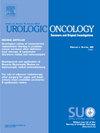热消融治疗既往肾部分切除术后局部肿瘤复发:围手术期和肿瘤预后。
IF 2.4
3区 医学
Q3 ONCOLOGY
Urologic Oncology-seminars and Original Investigations
Pub Date : 2025-04-24
DOI:10.1016/j.urolonc.2025.03.018
引用次数: 0
摘要
目的:经皮热消融(PTA)已成为一种替代挽救性根治性肾切除术(RN)治疗肾细胞癌(RCC)局部复发的方法。我们报告了接受PTA治疗的RCC局部复发患者的围手术期和肿瘤预后。材料与方法:2008 - 2022年27例原位复发患者接受PTA治疗。主要终点是围手术期结局、并发症和再入院率。次要终点为肿瘤原位复发和肿瘤外复发。最后,我们收集了PTA后的肾功能结果。结果:中位(IQR)治疗时间为75(63-106)分钟。术中并发症1例(3.7%),术后并发症2例(7.4%)。3例(11%)患者接受了不完全消融,其中1例需要辅助PTA, 2例需要RN。总体而言,4例(16%)患者在中位随访30(23-43)个月后出现局部复发:3例患者通过后续PTA实现了局部完全控制,而1例患者发生骨转移,因此未进行其他局部治疗。此外,6例(24%)患者在中位随访16个月(10-23个月)后出现外复发。最后,在PTA后1个月和1年的中位肌酐下降为-0.03(-0.11至0.01)和-0.11(-0.20至-0.05),而中位eGFR下降为2(0-7.65)和9.5(5-13.45)。结论:PTA是一种安全可行的治疗PN术后现场复发的方法。大多数患者围手术期并发症发生率低,局部肿瘤控制效果好,残余肾功能无明显损害。本文章由计算机程序翻译,如有差异,请以英文原文为准。
Thermal ablation for local tumor recurrence after previous partial nephrectomy: Perioperative and oncological outcomes
Objectives
Percutaneous thermal ablation (PTA) has emerged as an alternative to salvage radical nephrectomy (RN) for the treatment of renal cell carcinoma (RCC) local recurrence. We report perioperative and oncological outcomes of patients treated with PTA for RCC local recurrence.
Materials and methods
Twenty-seven patients with on-site recurrence received PTA from 2008 to 2022. Primary endpoints were perioperative outcomes, complications, and readmission rates. Secondary endpoints were on site and out site tumor recurrence. Last, we collected renal function outcomes after PTA.
Results
Median (IQR) treatment time was 75 (63–106) minutes. Intraoperative complications occurred in 1 (3.7%) patient, while postoperative in 2 (7.4%). Three patients (11%) received incomplete ablation, which required in one an adjunctive PTA and in 2 RN. Overall, 4 (16%) patients developed on site recurrence after a median follow-up of 30 (23–43) months: complete local control was achieved with subsequent PTA in 3 patients, while one developed bone metastases and, therefore, no other local treatments were performed. Moreover, 6 (24%) patients developed out-site recurrence after a median follow-up of 16 (10–23) months. Last, median creatinine drop at 1 month and at 1 year after PTA was -0.03 (-0.11 to 0.01) and -0.11 (-0.20 to -0.05), while median eGFR drop was 2 (0–7.65) and 9.5 (5–13.45).
Conclusion
PTA is a safe and feasible approach for management of on-site recurrences after PN. Low perioperative complication rates and optimal local cancer control were achieved in most patients, with no significant impairment of residual renal function.
求助全文
通过发布文献求助,成功后即可免费获取论文全文。
去求助
来源期刊
CiteScore
4.80
自引率
3.70%
发文量
297
审稿时长
7.6 weeks
期刊介绍:
Urologic Oncology: Seminars and Original Investigations is the official journal of the Society of Urologic Oncology. The journal publishes practical, timely, and relevant clinical and basic science research articles which address any aspect of urologic oncology. Each issue comprises original research, news and topics, survey articles providing short commentaries on other important articles in the urologic oncology literature, and reviews including an in-depth Seminar examining a specific clinical dilemma. The journal periodically publishes supplement issues devoted to areas of current interest to the urologic oncology community. Articles published are of interest to researchers and the clinicians involved in the practice of urologic oncology including urologists, oncologists, and radiologists.

 求助内容:
求助内容: 应助结果提醒方式:
应助结果提醒方式:


